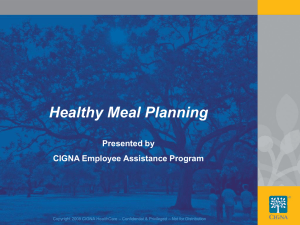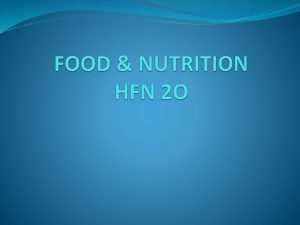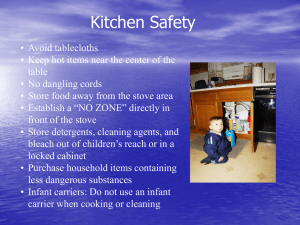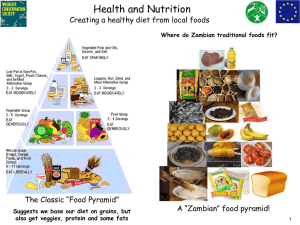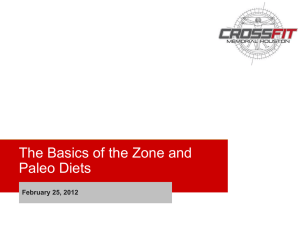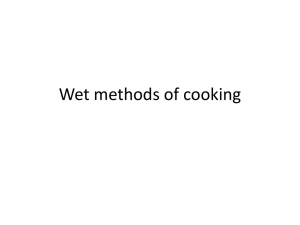Cooking - ScoutLander
advertisement
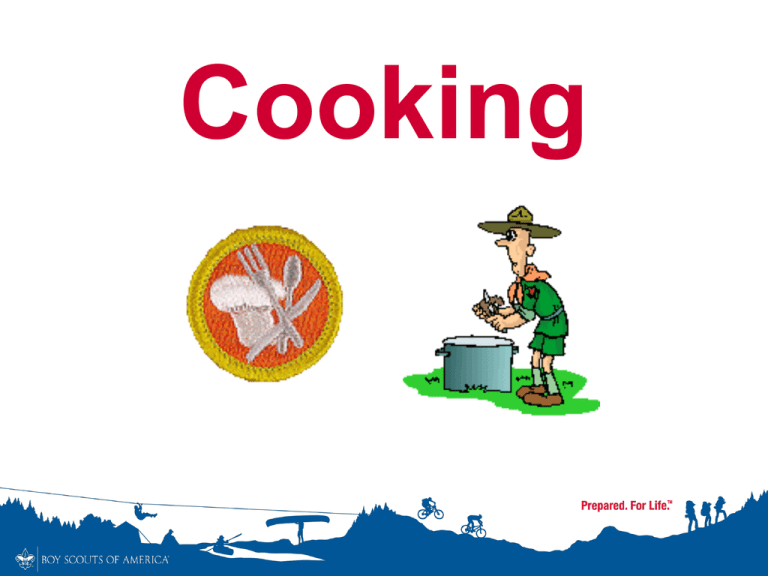
Cooking Fill in the Blanks – Counselor, Your Name, Unit & Number Cooking Cooking Cooking 1. Do the following: a. Explain to your counselor the most likely hazards you may encounter while participating in cooking activities and what you should do to anticipate, help prevent, mitigate, and respond to these hazards. b. Show that you know first aid for and how to prevent injuries or illnesses that could occur while preparing meals and eating, including burns and scalds, cuts, choking, and allergic reactions. c. Describe how meat, fish, chicken, eggs, dairy products, and fresh vegetables should be stored, transported, and properly prepared for cooking. Explain how to prevent cross-contamination. d. Describe the following food-related illnesses and tell what you can do to help prevent each from happening: 1. Salmonella 2. Staphylococcal aureus 3. Escherichia coli (E. coli) 4. Clostridium botulinum (Botulism) 5. Campylobacter jejuni 6. Hepatitis 7. Listeria monocytogenes 8. Cryptosporidium 9. Norovirus e. Discuss with your counselor food allergies, food intolerance, food-related diseases, and your awareness of these concerns. 1. a. Explain to your counselor the most likely hazards you may encounter while participating in cooking activities and what you should do to anticipate, help prevent, mitigate, and respond to these hazards. 1. b. Show that you know first aid for and how to prevent injuries or illnesses that could occur while preparing meals and eating, including burns and scalds, cuts, choking, and allergic reactions. 1. c. Describe how meat, fish, chicken, eggs, dairy products, and fresh vegetables should be stored, transported, and properly prepared for cooking. Explain how to prevent cross-contamination. Cooking over a campfire or camp stove is an enjoyable part of camping. However, meat and poultry may contain bacteria which if prepared and stored improperly can lead to food borne illness. Improperly stored foods may also attract wildlife such as bears. Food safety involves keeping hot foods hot and cold foods cold, in addition to storing food in animal and bug proof containers. The proper preparation and storage of food can help ensure a safe and enjoyable camping trip. Keep hot foods hot and cold foods cold. Most bacteria do not grow in temperatures less than 40 degrees Fahrenheit or at temperatures above 140 degrees Fahrenheit. The area in between is the zone in which bacteria growth can occur quickly. Store cooked and raw foods cold in a cooler that has a source of coldness such as frozen ice packs or frozen juice packages. Different types of coolers are available. Foam coolers are light, inexpensive and retain coldness; however, they are less durable than plastic, steel or fiberglass coolers. Coolers made of fiberglass, plastic or steel retain coldness well but are much heavier when full than foam coolers. For non-electric coolers, use a thick block of ice as a cold source as it will stay frozen longer than cubed or crushed ice. You can make your own ice block by filling a clean juice or milk carton with water and freezing or by using frozen gel-packs. 1 of 2 Keep food preparation areas free from cross contamination. Juices from raw meats and poultry contain bacteria which can be spread to other surfaces such as utensils, cutting areas and hands, and will contaminate other food items. Transport raw meats and poultry in plastic wrap or place in resealable bags to prevent juices from dripping onto other foods. Cooked meat and poultry is considered safe to eat when it reaches the following minimum internal temperatures: 145 degrees Fahrenheit for beef, veal, and lamb steaks, roasts and chops; 160 degrees Fahrenheit for ground beef, veal and lamb and other cuts of meat; and 165 degrees Fahrenheit for all poultry products. Processed foods such as hot dogs and leftover foods should also be cooked to 165 degrees Fahrenheit. The thermometer should be cleaned between uses to avoid bacteria growth or cross-contamination. 2 of 2 1. c. Describe the following food-related illnesses and tell what you can do to help prevent each from happening: 1. Salmonella enteritis Salmonella enteritidis Infection Egg-associated salmonellosis is an important public health problem in the United States and several European countries. A bacterium, Salmonella enteritidis, can be inside perfectly normal-appearing eggs, and if the eggs are eaten raw or undercooked, the bacterium can cause illness. During the 1980s, illness related to contaminated eggs occurred most frequently in the northeastern United States, but now illness caused by S. enteritidis is increasing in other parts of the country as well. Consumers should be aware of the disease and learn how to minimize the chances of becoming ill.A person infected with the Salmonella enteritidis bacterium usually has fever, abdominal cramps, and diarrhea beginning 12 to 72 hours after consuming a contaminated food or beverage. The illness usually lasts 4 to 7 days, and most persons recover without antibiotic treatment. However, the diarrhea can be severe, and the person may be ill enough to require hospitalization. What You Can Do to Reduce Risk Eggs, like meat, poultry, milk, and other foods, are safe when handled properly. Shell eggs are safest when stored in the refrigerator, individually and thoroughly cooked, and promptly consumed. The larger the number of Salmonella present in the egg, the more likely it is to cause illness. Keeping eggs adequately refrigerated prevents any Salmonella present in the eggs from growing to higher numbers, so eggs should be held refrigerated until they are needed. Cooking reduces the number of bacteria present in an egg; however, an egg with a runny yolk still poses a greater risk than a completely cooked egg. Undercooked egg whites and yolks have been associated with outbreaks of Salmonella enteritidis infections. Both should be consumed promptly and not be held in the temperature range of 40 degrees to 140 degrees for more than 2 hours. 1 of 9 2. Staphylococcal enteritis an inflammation that is usually caused by eating or drinking substances contaminated with staph enterotoxin. but can be the result of toxins that may have been left in the food due to improper handling prior to its consumption. The toxin, not the bacterium, settles in the small intestine and cause inflammation and swelling. This in turn can cause abdominal pain, cramping, dehydration, diarrhea and fever Staphylococcal enteritis may be avoided by using proper hygiene and sanitation with food preparation. This includes thoroughly cooking all meats. If food is to be stored longer than two hours, keep hot foods hot (over 140°F) and cold foods cold (40°F or under). Ensure to refrigerate leftovers promptly and store cooked food in a wide, shallow container and refrigerate as soon as possible. Sanitation is very important. Keep kitchens and food-serving areas clean and sanitized. Finally, as most Staphylococcal food poisoning are the result of food handling, hand washing is critical. Food handlers should use hand sanitizers with alcohol or through hand washing with soap and water 2 of 9 3. Escherichia coli enteritis (E. coli) One strain (E. coli O157:H7) can cause a severe case of food poisoning. Bacteria may get into your food in different ways: Meat or poultry may come into contact with normal bacteria from the intestines of an animal while it is being processed. water used during growing or shipping may contain animal or human waste. Food may be handled in an unsafe way during transport or storage. Unsafe food handling or preparation in grocery stores, restaurants, or homes Food poisoning can occur after eating or drinking: Any food prepared by someone who did not wash their hands well Any food prepared using unclean cooking utensils, cutting boards, or other tools Dairy products or food containing mayonnaise (such as coleslaw or potato salad) which have been out of the refrigerator too long Frozen or refrigerated foods that are not stored at the proper temperature or are not properly reheated Fish or oysters Raw fruits or vegetables that have not been washed well Raw vegetable or fruit juices and dairy products Undercooked meats or eggs Water from a well or stream, or city or town water that has not been treated Although not common, E. coli can be spread from one person to another. This may happen when someone does not wash his or her hands after a bowel movement and then touches other objects or someone else's hands. 3 of 9 4. Botulism There are five main kinds of botulism. Foodborne botulism is caused by eating foods that contain the botulinum toxin. Wound botulism is caused by toxin produced from a wound infected with Clostridium botulinum. Infant botulism is caused by consuming the spores of the botulinum bacteria, which then grow in the intestines and release toxin. Adult intestinal toxemia (adult intestinal colonization) botulism is a very rare kind of botulism that occurs among adults by the same route as infant botulism. Lastly, iatrogenic botulism can occur from accidental overdose of botulinum toxin. All forms of botulism can be fatal and are considered medical emergencies. Foodborne botulism is a public health emergency because many people can be poisoned by eating a contaminated food. Many cases of botulism are preventable. Foodborne botulism has often been from homecanned foods with low acid content, such as asparagus, green beans, beets and corn and is caused by failure to follow proper canning methods. However, seemingly unlikely or unusual sources are found every decade, with the common problem of improper handling during manufacture, at retail, or by consumers; some examples are chopped garlic in oil, canned cheese sauce, chile peppers, tomatoes, carrot juice, and baked potatoes wrapped in foil. 4 of 9 5. Campylobacter jejuni Campylobacter jejuni is a species of bacteria commonly found in animal feces. It is a curved, helical-shaped, non-spore forming, Gram-negative, microaerophilic bacteria. It is one of the most common causes of human gastroenteritis in the world. Food poisoning caused by Campylobacter species can be severely debilitating, but is rarely life-threatening. It has been linked with subsequent development of Guillain-Barré syndrome (GBS), which usually develops two to three weeks after the initial illness. 5 of 9 6. Hepatitis "Hepatitis" means inflammation of the liver and also refers to a group of viral infections that affect the liver . The most common types are Hepatitis A, Hepatitis B, and Hepatitis C. Viral hepatitis is the leading cause of liver cancer and the most common reason for liver transplantation. An estimated 4.4 million Americans are living with chronic hepatitis; most do not know they are infected. Prevention Talk to your doctor about vaccination for hepatitis A and hepatitis B. Lifestyle measures for preventing spread of hepatitis B and C from one person to another include: Avoid sharing personal items, such as razors or toothbrushes. Do not share drug needles or other drug equipment (such as straws for snorting drugs). Clean blood spills with a solution containing 1 part household bleach to 9 parts water. Be careful when getting tattoos and body piercings. To reduce your risk of spreading or catching hepatitis A: Always wash your hands thoroughly after using the restroom and when you come in contact with aninfected person's blood, stools, or other bodily fluid. Avoid unclean food and water. 6 of 9 7. Listeria monocytogenes Listeria monocytogenes is the bacterium that causes the infection listeriosis. It is a facultative anaerobic bacterium, capable of surviving in the presence or absence of oxygen. It can grow and reproduce inside the host's cells and is one of the most virulent food-borne pathogens, with 20 to 30 percent of clinical infections resulting in death. Responsible for an estimated 1,600 illnesses and 260 deaths in the United States (U.S.) annually. A bacteriophage, Listeria phage P100, has been proposed as food additive to control Listeria monocytogenes. Bacteriophage treatments have been developed by several companies. EBI Food Safety and Intralytix both have products suitable for treatment of the bacterium. The U.S. Food and Drug Administration (FDA) approved a cocktail of six bacteriophages from Intralytix, and a one type phage product from EBI Food Safety designed to kill L. monocytogenes. Uses would potentially include spraying it on fruits and ready-to-eat meat such as sliced ham and turkey. 7 of 9 8. Cryptosporidium Cryptosporidium is a genus of apicomplexan protozoans that can cause gastrointestinal illness with diarrhea in humans. Cryptosporidium is the organism most commonly isolated in HIVpositive patients presenting with diarrhea. Treatment is symptomatic, with fluid rehydration, electrolyte correction and management of any pain. Many treatment plants that take raw water from rivers, lakes, and reservoirs for public drinking water production use conventional filtration technologies. Direct filtration, which is typically used to treat water with low particulate levels, includes coagulation and filtration but not sedimentation. Other common filtration processes including slow sand filters, diatomaceous earth filter, and membranes will remove 99% of Cryptosporidium. Membranes and bag- and cartridge-filter products remove Cryptosporidium specifically. 8 of 9 9. Norovirus Norovirus infection is characterized by nausea, forceful vomiting, watery diarrhea, and abdominal pain, and in some cases, loss of taste. General lethargy, weakness, muscle aches, headache, coughs, and low-grade fever may occur. The disease is usually self-limiting, and severe illness is rare. The virus affects around 267 million people and causes over 200,000 deaths each year; these deaths are usually in less developed countries and in the very young, elderly and immuno-suppressed Hand washing with soap and water is an effective method for reducing the transmission of norovirus pathogens. Alcohol rubs (≥62% ethanol) may be used as an adjunct, but are less effective than hand-washing, as norovirus lacks a lipid viral envelope. Surfaces where norovirus particles may be present can be sanitised with a solution of 1.5% to 7.5% of household bleach in water, or other disinfectants effective against norovirus. 9 of 9 1. e. Discuss with your counselor food allergies, food intolerance, food-related diseases, and your awareness of these concerns. food allergy is an abnormal response to food that is triggered by a specific reaction in the immune system and expressed by certain, often characteristic, symptoms. Other kinds of reactions to foods that are not food allergies include food intolerances (such as lactose or milk intolerance), food poisoning, and toxic reactions. Food intolerance also is an abnormal response to food, and its symptoms can resemble those of food allergy. Food intolerance, however, is far more prevalent, occurs in a variety of diseases, and is triggered by several different mechanisms that are distinct from the immunological reaction responsible for food allergy. 1. e. Discuss with your counselor food allergies, food intolerance, food-related diseases, and your awareness of these concerns. Food intolerance or non-allergic food hypersensitivity is a term used widely for varied physiological responses associated with a particular food, or compound found in a range of foods. Food intolerance is a detrimental reaction, often delayed, to a food, beverage, food additive, or compound found in foods that produces symptoms in one or more body organs and systems, but it is not a true food allergy. A true food allergy requires the presence of immune mechanisms (as for instance Immunoglobin E - IgE antibodies) against the food, and a food intolerance does not. Food intolerances can be classified according to their mechanism. Intolerance can result from the absence of specific chemicals or enzymes needed to digest a food substance, as in hereditary fructose intolerance. It may be a result of an abnormality in the body's ability to absorb nutrients, as occurs in fructose malabsorption. Food intolerance reactions can occur to naturally occurring chemicals in foods, as in salicylate sensitivity. Drugs sourced from plants, such as aspirin, can also cause these kinds of reactions. Finally, it may be the result of non-IgEmediated immune responses. 1. e. Discuss with your counselor food allergies, food intolerance, food-related diseases, and your awareness of these concerns. The complex process of digestion affects the timing, location, and particular symptoms of an allergic reaction to food. All of the symptoms of food allergy occur within a few minutes to an hour of eating. A food allergy can initially be experienced as an itching in the mouth and difficulty swallowing and breathing. Then, during digestion of the food in the stomach and intestines, symptoms such as nausea, vomiting, diarrhea, and abdominal pain can start. Incidentally, the gastrointestinal symptoms of food allergy are those that are most often confused with the symptoms of different types of food intolerance. the allergens are absorbed and enter the bloodstream. When they reach the skin, allergens can induce hives or eczema, and when they reach the airways, they can cause asthma. As the allergens travel through the blood vessels, they can cause lightheadedness, weakness, and anaphylaxis, which is a sudden drop in blood pressure. Anaphylactic reactions are severe even when they start off with mild symptoms, such as a tingling in the mouth and throat or discomfort in the abdomen. They can be fatal if not treated quickly. 1. e. Discuss with your counselor food allergies, food intolerance, food-related diseases, and your awareness of these concerns. Foodborne illness (also foodborne disease and colloquially referred to as food poisoning) is any illness resulting from the consumption of contaminated food, pathogenic bacteria, viruses, or parasites that contaminate food, as well as chemical or natural toxins such as poisonous mushrooms. Symptoms vary depending on the cause. A few broad generalizations can be made, e.g.: The incubation period ranges from hours to days, depending on the cause and on how much was consumed. The incubation period tends to cause sufferers to not associate the symptoms with the item consumed, and so to cause sufferers to attribute the symptoms to stomach flu for example. Symptoms often include vomiting, fever, and aches, and may include diarrhea. Bouts of vomiting can be repeated, with an extended delay in between, because even if infected food was eliminated from the stomach in the first bout, microbes (if applicable) can have passed through the stomach into the intestine, attached to the cells lining the intestinal walls, and begun to multiply there. Some types of microbes stay in the intestine, some produce a toxin that is absorbed into the bloodstream, and some can directly invade deeper body tissues. 2. Do the following: a. Using the MyPlate food guide or the current USDA nutrition model, give five examples for EACH of the following food groups, the recommended number of daily servings, and the recommended serving size: 1. Fruits 2. Vegetables 3. Grains 4. Proteins 5. Dairy b. Explain why you should limit your intake of oils and sugars. c. Determine your daily level of activity and your caloric need based on your activity level. Then, based on the MyPlate food guide, discuss with your counselor an appropriate meal plan for yourself for one day. d. Discuss your current eating habits with your counselor and what you can do to eat healthier, based on the MyPlate food guide. Portion Distortion Cookies as big as frisbees. Muffins the size of flower pots. Bowls of pasta so deep, your fork can barely find the bottom. One reason people's waistlines have expanded over the past few decades is because food portions have too. People today eat way more than they used to — and way more than they need to. This means that they're constantly taking in more calories than their bodies can burn. Unfortunately, lots of us don't realize that we're eating too much because we've become so used to seeing (and eating!) large portions. 2. c. Determine your daily level of activity and your caloric need based on your activity level. Then, based on the MyPlate food guide, discuss with your counselor an appropriate meal plan for yourself for one day. https://www.supertracker.usda.gov/myplan.aspx Both the type and amount of fat you consume are important. High fat consumption makes it more likely you will gain weight because fats contain nine calories per gram compared to the four calories per gram found in carbohydrate and protein. Two types of fat, saturated fat and trans fats, are bad for you, increasing your risk for high cholesterol, heart disease and type 2 diabetes. While most types of oils consist mainly of healthier unsaturated fats, tropical oils like coconut oil and palm oil are relatively high in saturated fat. Diets high in added sugars may increase your risk for cavities, obesity and chronic diseases, according to the World Health Organization. Sugary foods often displace healthier foods in the diet, limiting the consumption of essential nutrients. Read labels to figure out which processed foods contain added sugars; even foods that don't taste sweet often contain some added sugar, including condiments and breads. Sugars are also listed under multiple names. Keep an eye out for fruit juice concentrate, honey, glucose, fructose, maltose, dextrose, corn syrup, molasses and malt syrup. Here are general tips for healthy eating: *MEASURE your food. Calories can sneak up on you in portions that are larger than you think! *ADD some protein to each meal. It is filling and keeps the hunger away for longer. *PREPARE healthy snacks in advance. Keep them in baggies, ready to grab and calorie proportioned. *COUNT your calories. Figure out how many calories you need per day (to either gain, maintain, or lose weight) and use that as a guide. There’s a simple calorie calculator here. If you can cut out 3500 calories/week (through increasing exercise and eating less) you can lose about 1 lb per week. Tracking what you eat (at least for a month) will teach you what to eat and how much of it is the right amount. https://www.supertracker.usda.gov/myplan.aspx 3. Do the following: a. Discuss the following food label terms: calorie, fat, saturated fat, trans fat, cholesterol, sodium, carbohydrate, dietary fiber, sugar, protein. Explain how to calculate total carbohydrates and nutritional values for two servings, based on the serving size specified on the label. b. Refer to “How to Read a Food Label” in the Cooking merit badge pamphlet, and name ingredients that help the consumer identify the following allergens: peanuts, tree nuts, milk, eggs, wheat, soy, and shellfish. Calorie The small calorie or gram calorie (symbol: cal) is the approximate amount of energy needed to raise the temperature of one gram of water by one degree Celsius. The large calorie, kilogram calorie, dietary calorie, nutritionist's calorie or food calorie (symbol: Cal, equiv: kcal) is the amount of energy needed to raise the temperature of one kilogram of water by one degree Celsius. The large calorie is thus equal to 1000 small calories or one kilocalorie fat saturated fat trans fat wide group of compounds that are generally soluble in organic solvents and generally insoluble in water. Chemically, fats are triglycerides: triesters of glycerol and any of several fatty acids. Fats may be either solid or liquid at room temperature, depending on their structure and composition. Although the words "oils", "fats", and "lipids" are all used to refer to fats, in reality, fat is a subset of lipid.[ A fat's constituent fatty acids may also differ in the C/H ratio. When all three fatty acids have the formula CnH(2n+1)CO2H, the resulting fat is called "saturated". Values of n usually range from 13 to 17. Each carbon atom in the chain is saturated with hydrogen, meaning they are bonded to as many hydrogens as possible. Unsaturated fats are derived from fatty acids with the formula CnH(2n-1)CO2H. These fatty acids contain double bonds within carbon chain. This results in an "unsaturated" fatty acid. Most trans-isomer fats (commonly called trans fats) are commercially produced; trans fatty acids are rare in nature. The cis-isomer introduces a kink into the molecule that prevents the fats from stacking efficiently as in the case of fats with saturated chains cholesterol sodium carbohydrate Your body needs some cholesterol to make hormones, vitamin D, and substances that help you digest foods. Your body makes all the cholesterol it needs. However, cholesterol also is found in some of the foods you eat. Cholesterol travels through your bloodstream in small packages called lipoproteins (lip-o-PRO-teens). These packages are made of fat (lipid) on the inside and proteins on the outside. Two kinds of lipoproteins carry cholesterol throughout your body: low-density lipoproteins (LDL) and high-density lipoproteins (HDL). Having healthy levels of both types of lipoproteins is important. Sodium is a major mineral found in the fluid surrounding the cells in your body where it helps to regulate blood pressure and fluid volume, and it also helps maintain pH balance. Your muscles and nervous system also need sodium to function properly. The most common form of sodium is table salt, but at least a little bit of sodium occurs naturally in many foods. Significant sources include dairy products, beets, and celery. Processed foods usually contain a lot of sodium in the form of preservatives and flavor enhancers. Carbohydrates, or saccharides, are sugars and starches, which provide energy for humans and animals, and cellulose which make up many plant structures. “Carbs,” as they are now commonly referred to, have become both a blessing and a curse, as the process of modern food production has changed the way they are consumed. There are two types of carbohydrates, simple, or monosaccharides and complex, or polysaccharides. dietary fiber sugar protein Dietary fiber is defined as the parts of plants that cannot be digested in our bodies. They pass through the small intestine and are partially fermented in the large intestine. There are two types of dietary fiber, soluble and insoluble. Consuming more of both forms of fiber has been linked to greater longevity, through a reduction in cardiovascular disease, respiratory diseases (like pneumonia and chronic obstructive pulmonary disease, or COPD), and infectious diseases (like tuberculosis). Sugar is the generalized name for a class of chemically-related sweet-flavored substances, most of which are used as food. They are carbohydrates, composed of carbon, hydrogen and oxygen. There are various types of sugar derived from different sources. Simple sugars are called monosaccharides and include glucose (also known as dextrose), fructose and galactose. The table or granulated sugar most customarily used as food is sucrose, a disaccharide (in the body, sucrose hydrolyses into fructose and glucose). Other disaccharides include maltose and lactose. large biological molecules, or macromolecules, consisting of one or more chains of amino acid residues. Proteins perform a vast array of functions within living organisms, including catalyzing metabolic reactions, replicating DNA, responding to stimuli, and transporting molecules from one location to another. Proteins differ from one another primarily in their sequence of amino acids, which is dictated by the nucleotide sequence of their genes, and which usually results in folding of the protein into a specific three-dimensional structure that determines its activity. A calorie is a unit that measures the amount of energy that food provides to the body. The body turns food into fuel after it's been eaten, burning it to produce energy. Calories in food come from carbohydrates, proteins and fats. Carbohydrates contain 4 calories per gram, the same as proteins. Fats contain 9 calories per gram. Although calories from carbohydrates are all the same, their nutritional values aren't. How to Calculate Calories From Carbohydrate Grams Instructions 1 Find the nutritional index on the food packaging. The index lists the number of carbohydrate grams per serving. For fresh foods or for foods without packaging, use an online tool to help find the serving size and nutritional index. 2 Multiply the number of servings eaten by the number of carbohydrate grams per serving to get the total number of carbohydrate grams consumed. 3 Multiply the total number of carbohydrate grams eaten by 4 to get the carbohydrate calorie intake. 3. b. Refer to “How to Read a Food Label” in the Cooking merit badge pamphlet, and name ingredients that help the consumer identify the following allergens: peanuts, tree nuts, milk, eggs, wheat, soy, and shellfish. 3. b. Refer to “How to Read a Food Label” in the Cooking merit badge pamphlet, and name ingredients that help the consumer identify the following allergens: peanuts, tree nuts, milk, eggs, wheat, soy, and shellfish. 4. Do the following: a. Discuss EACH of the following cooking methods. For each one, describe the equipment needed and name at least one food that can be cooked using that method: baking, boiling, pan frying, simmering, steaming, microwaving, and grilling. b. Discuss the benefits of using a camp stove on an outing vs. a charcoal or wood fire. c. Discuss how the Outdoor Code and no-trace principles pertain to cooking in the outdoors. Baking is a food cooking method that uses prolonged dry heat by convection, rather than by thermal radiation, normally in an oven, but also in hot ashes, or on hot stones. The most common baked item is bread but many other types of foods are baked. Heat is gradually transferred "from the surface of cakes, cookies and breads to their centre. As heat travels through it transforms batters and doughs into baked goods with a firm dry crust and a softer centre". Boiling is the rapid vaporization of a liquid, which occurs when a liquid is heated to its boiling point, the temperature at which the vapor pressure of the liquid is equal to the pressure exerted on the liquid by the surrounding environmental pressure. Pan frying is a form of frying characterized by the use of minimal cooking oil or fat (compared to shallow frying or deep frying); typically using just enough oil to lubricate the pan (although, in the case of a greasy food such as bacon, no oil or fats may be needed). As a form of frying, pan frying relies on oil as the heat transfer medium and on correct temperature and time to retain the moisture in the food. Because of the partial coverage, the food must be flipped at least once to cook both sides. Simmering is a food preparation technique in which foods are cooked in hot liquids kept at or just below the boiling point of water (which is 100 °C or 212 °F at average sea level air pressure), but higher than poaching temperature. To keep a pot simmering, one brings it to a boil and then reduces the heat to a point where the formation of bubbles has all but ceased, typically a water temperature of about 94 °C (200 °F). Steaming works by boiling water continuously, causing it to vaporize into steam; the steam then carries heat to the nearby food, thus cooking the food. The food is kept separate from the boiling water but has direct contact with the steam, resulting in a moist texture to the food. This differs from double boiling, in which contact with steam is undesired. Microwave is a kitchen appliance that heats food by bombarding it with electromagnetic radiation in the microwave spectrum causing polarized molecules in the food to rotate and build up thermal energy in a process known as dielectric heating. Microwave ovens heat foods quickly and efficiently because excitation is fairly uniform in the outer 25–38 mm of a dense (high water content) food item; food is more evenly heated throughout (except in thick, dense objects) than generally occurs in other cooking techniques. Grilling usually involves a significant amount of direct, radiant heat, and tends to be used for cooking meat quickly. Food to be grilled is cooked on a grill (an open wire grid such as a gridiron with a heat source above or below 4. b. Discuss the benefits of using a camp stove on an outing vs. a charcoal or wood fire. Propane burns cleanly and efficiently, and produces a hot, steady flame. Also, it works well at high altitude and temperatures well below freezing. However, most propane stoves are too heavy for backpacking, since regulations require propane canisters to be thick, heavy steel. Flavor: “When you’re cooking over a charcoal fire, the natural woodsmoke flavors complement the food,” cooking with wood takes a lot longer than on a gas or charcoal grill. If you are cooking on a grill grate over firewood, you ideally want to cook on glowing embers, not on open flames which will char and burn your food. To get that core of hot wood embers takes time and a lot of wood. 4. c. Discuss how the Outdoor Code and no-trace principles pertain to cooking in the outdoors Minimize Campfire Impacts Campfires can cause lasting impacts to the backcountry. Use a lightweight stove for cooking. Where fires are permitted, use established fire rings, fire pans, or mound fires. Keep fires small. Only use sticks from the ground that can be broken by hand. Burn all wood and coals to ash, put out campfires completely, then scatter cool ashes. Note: The meals prepared for Cooking merit badge requirements 5, 6, and 7 will count only toward fulfilling those requirements and will not count toward rank advancement. Meals prepared for rank advancement may not count toward the Cooking merit badge. You must not repeat any menus for meals actually prepared or cooked in requirements 5, 6, and 7. 5. Using the MyPlate food guide or the current USDA nutrition model, plan a menu for three full days of meals (three breakfasts, three lunches, and three dinners) plus one dessert. Your menu should include enough to feed yourself and at least one adult, keeping in mind any special needs (such as food allergies) of those to be served. List the equipment and utensils needed to prepare and serve these meals. Then do the following: a. Create a shopping list for your meals showing the amount of food needed to prepare and serve each meal, and the cost for each meal. b. Share and discuss your meal plan and shopping list with your counselor. c. Using at least five of the seven cooking methods from requirement 4, prepare and serve yourself and at least one adult (parent, family member, guardian, or other responsible adult) one breakfast, one lunch, one dinner, and one dessert from the meals you planned.* d. Time your cooking to have each meal ready to serve at the proper time. Have an adult verify the preparation of the meal to your counselor. e. After each meal, ask a person you served to evaluate the meal on presentation and taste, then evaluate your own meal. Discuss what you learned with your counselor, including any adjustments that could have improved or enhanced your meals. Tell how better planning and preparation help ensure a successful meal. f. Explain how you kept foods safe and free from cross-contamination. 6. Using the MyPlate food guide or the current USDA nutrition model, plan a menu for your patrol (or a similar size group of up to eight youth, including you) for a camping trip. Include five meals AND at least one snack OR one dessert. List the equipment and utensils needed to prepare and serve these meals. Then do the following: a. Create a shopping list for your meals showing the amount of food needed to prepare and serve each meal, and the cost for each meal. b. Share and discuss your meal plan and shopping list with your counselor. c. In the outdoors, cook two of the meals you planned in requirement 6 using either a lightweight stove or a low-impact fire. Use a different cooking method for each meal.** The same fireplace may be used for both meals. Serve this meal to your patrol or a group of youth. d. In the outdoors, cook one of the meals you planned in requirement 6. Use either a Dutch oven, OR a foil pack, OR kabobs. Serve this meal to your patrol or a group of youth.** e. In the outdoors, prepare a dessert OR a snack and serve it to your patrol or a group of youth.** * The meals for requirement 5 may be prepared on different days, and they need not be prepared consecutively. The requirement calls for Scouts to plan, prepare, and serve one breakfast, one lunch, and one dinner to at least one adult; those served need not be the same for all meals. ** Where local regulations do not allow you to build a fire, the counselor may adjust the requirement to meet the law. The meals in requirements 6 and 7 may be prepared for different trips and need not be prepared consecutively. Scouts working on this badge in summer camp should take into consideration foods that can be obtained at the camp commissary. f. After each meal, have those you served evaluate the meal on presentation and taste, and then evaluate your own meal. Discuss what you learned with your counselor, including any adjustments that could have improved or enhanced your meals. Tell how better planning and preparation help ensure successful outdoor cooking. g. Explain how you kept foods safe and free from cross contamination. 7. Using the MyPlate food guide or the current USDA nutrition model, plan a menu for trail hiking or backpacking that includes one breakfast, one lunch, one dinner, and one snack. These meals must not require refrigeration and are to be consumed by three to five people (including you). List the equipment and utensils needed to prepare and serve these meals. Then do the following: a. Create a shopping list for your meals, showing the amount of food needed to prepare and serve each meal, and the cost for each meal. b. Share and discuss your meal plan and shopping list with your counselor. Your plan must include how to repackage foods for your hike or backpacking trip to eliminate as much bulk, weight, and garbage as possible. c. While on a trail hike or backpacking trip, prepare and serve two meals and a snack from the menu planned for requirement 7. At least one of those meals must be cooked over a fire, or an approved trail stove (with proper supervision).** d. For each meal prepared in requirement 7c, use safe foodhandling practices. Explain how you kept foods safe and free from cross-contamination. Clean up equipment, utensils, and the site thoroughly after each meal. Properly dispose of dishwater, and pack out all garbage. e. After each meal, have those you served evaluate the meal on presentation and taste, then evaluate your own meal. Discuss what you learned with your counselor, including any adjustments that could have improved or enhanced your meals. Tell how better planning and preparation help ensure successful trail hiking or backpacking meals. 8. Find out about three career opportunities in cooking. Select one and find out the education, training, and experience required for this profession. Discuss this with your counselor, and explain why this profession might interest you. Restaurant Manager Food critic Caterer Chef Nutritionist Culinary Instructor
